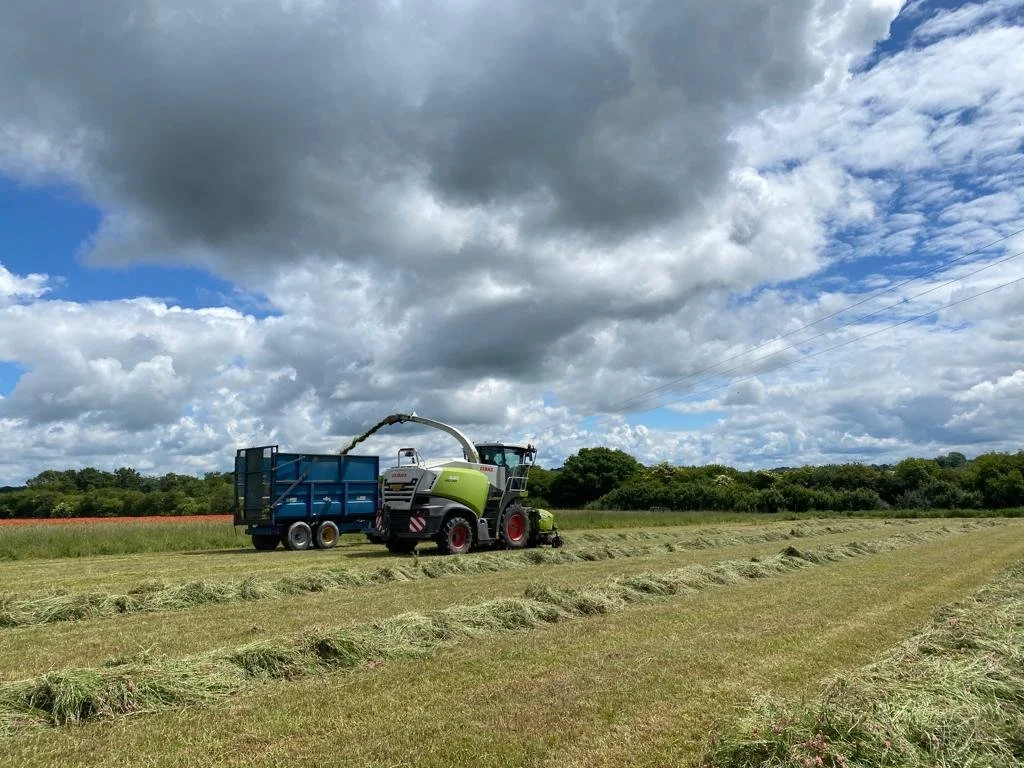A sustainable future
HOW CAN WE ADJUST FARMING PRACTICES AND MINDSETS FOR A SUSTAINABLE FUTURE?
The farming industry has been a focus for the media in recent years with respect to carbon emissions and wildlife decline. This prompts a certain amount of indignation from farmers; what do ‘they’ know about the struggles of food producers, most of whom view themselves as guardians of the British countryside? However ‘they’ may have a point. Farmers are not doing enough. Digging into the archives, we found these words from Henry Edmunds F.R.E.S, written nearly a decade ago, but as relevant today as they were then. He makes an articulate and compelling argument for positive change in the agricultural sector, with some practical suggestions too:
Silage making in action on The Cholderton Estate, destined to be fodder for our cattle
‘‘We often read of the drastic decline of wildlife in the UK and indeed around the world. Are we content to allow this remorseless process of environmental degradation to continue, unchecked, until the very mechanisms that permit the tenuous existence of life on this planet are themselves overturned? By increasing agricultural intensification; yet ignoring every environmental consideration; it is evident that we are dealing with an industry where most practitioners appear incapable of understanding the vital role that agriculture can make to ameliorate global warming. Agri chemicals applied so liberally over the countryside have effects far beyond the crops that they are helping to grow. The industry has been experimenting with the environment on a gigantic scale. Our water, soil, air, wildlife and ourselves have been contaminated by a sophisticated cocktail of potentially lethal chemicals. As the inherent fertility of soils, previously enriched by mixed farming practice, has diminished, so has the reliance on agri-chemicals increased. Yet, the pursuit of excessive yields has been promoted under the dictat of efficiency. But, if we really want to judge the efficiency of these highly intensive agricultural systems, then a price should be put on the environmental damage they cause.
It is evident that we need to be adapting the soil, by organic addition, to become a net carbon accumulator. This is best achieved by a mixed organic farming system. It must be more efficient for every farm to generate its own fertility by utilising a system of leguminous rich pasture rotation. This will form the patch work quilt landscape that, by its diversity, allows wildlife to thrive and minimises or negates the need to purchase expensive global warming inputs. This also fits the traditional view of the British countryside and because of its sustainability, may receive support in future agricultural subsidies. Mixed farming, rather than being emblematic of the past, is in reality a beacon to a more sustainable future where farming will be seen to provide food instead of industrial commodities and concurrently help the UK meet its carbon emissions targets whilst also restoring valuable wildlife habitats.”
Roe deer galloping through a mustard crop on The Cholderton Estate, captured by wildlife photographer Jenny Grewal MRCVS
“What can any individual do to address the issues posed by the loss of wildlife? The situation is not hopeless. Any farm can take action. It is purely a matter of basic recognition and appreciation of a range of birds, mammals and insects. These can be the ‘canaries in the mine’ and their presence or absence a mark of progress or regression. To take a small example; we all know of steep north facing banks; too steep to cultivate and which appear to be a prairie of dead grass. They will however carry a wealth of seed from plants that can no longer be seen to grow there. By initiating a sheep grazing regime over the winter; to remove the coarse grasses and open up areas of forage conservation, we can provide support to significant populations of birds, insects and bumblebees.”
words by Henry Edmunds F.R.E.S. (edited by Susie Edmunds & Sally Newton)


